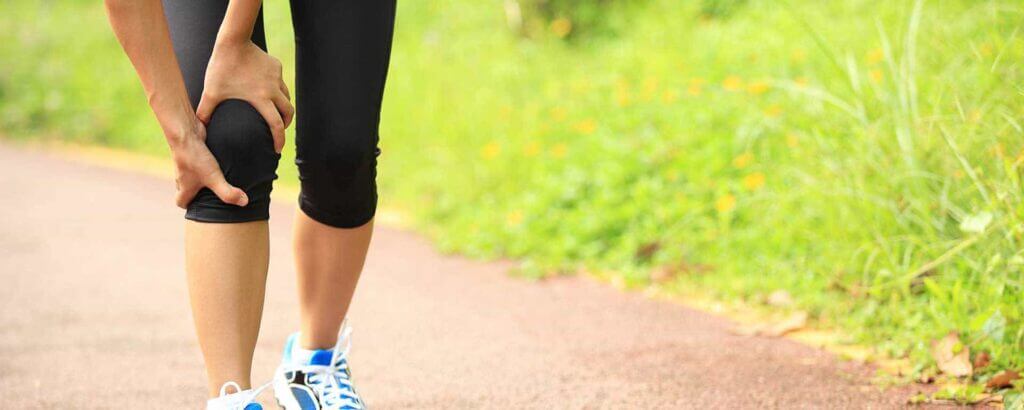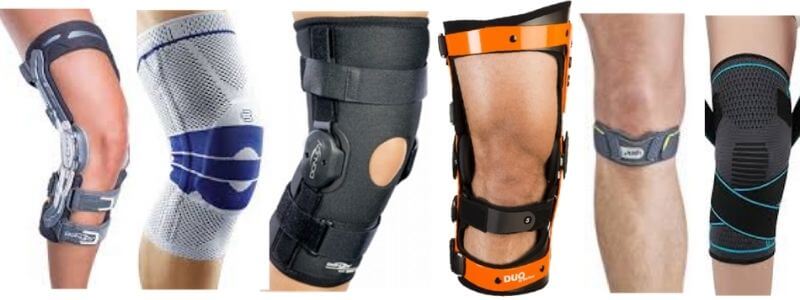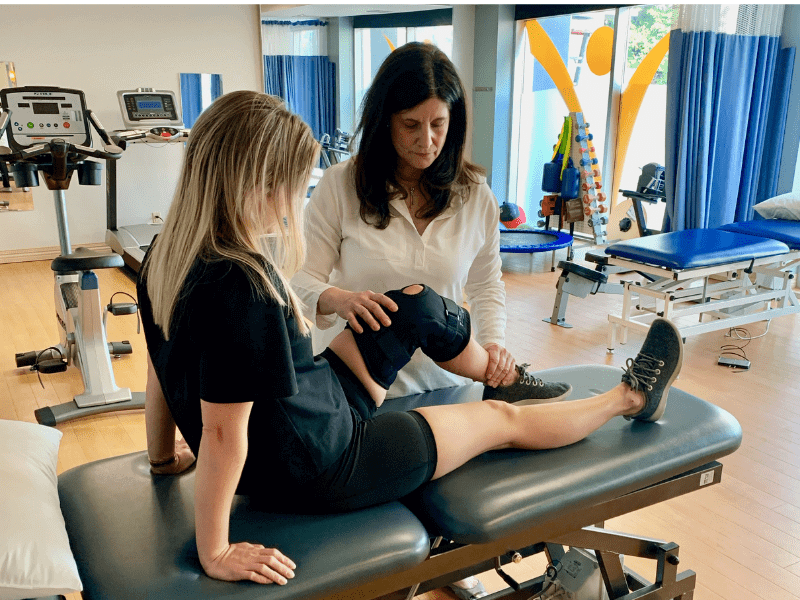5 Ways Knee Bracing Can Improve Your Pain!


Michelle DeMarchi
BSc PT, DOMP
Physiotherapist, Pelvic Health Physiotherapist, Bracing Specialist
Are you going to physiotherapy for a painful knee injury that’s interfering with your everyday activities…your exercise routine…or sports?
Well, you’re not alone…
BUT the good news is that knee bracing, along with good physiotherapy exercises, can help improve your pain and help you get moving again!
Knee bracing is often recommended by doctors and physiotherapists because it can help with many types of knee pain. Knee braces are comfortable and easy to find…but when are they really helpful?
Keep on reading to learn more about how different types of knee braces can help you
When can knee bracing help?
That’s a great question…and one that people ask me ALL the time.
You can wear a knee brace if you’re looking to:
- Reduce pain
- Control swelling
- Support your knee after an injury such as a sprain, ligament injury or torn meniscus
- Manage a chronic injury or osteoarthritis that has flared up
- Stabilize your knee if it’s prone to injury
- Support your knee so you can remain active with less pain
- How does knee bracing actually help you?
This is a BIG question because different types of braces will help you in different ways.
Dr. Daniel Warshafsky, Sports Medicine Physician at a physiotherapy clinic in Toronto, explains:
“Braces are made with various materials, functions and levels of support. They’re designed to help manage and distribute the pressure around your knee. Understanding your specific problem is the key to finding the type of brace that will help. “
In other words, identify whether your main problem is…pain, swelling, instability or osteoarthritis. And THEN you can start to understand how knee bracing will help you most.

More importantly, you also have to understand that knee bracing ALONE can only go so far…
And this is where a good physiotherapy program comes in…but more on that later 🙂
5 ways a knee bracing and physiotherapy can help your pain:
1. Hinged Knee Brace for Pain
Knee bracing helps reduce pain for the simple reason that it provides extra support and stability.
A hinged knee brace can give you comfort or peace of mind,. It can actually help a “wobbly” injured knee feel more stable when you walk.
A hinged knee brace with plastic supports provides added support for injuries that are more acute or painful. This, in fact, is the type of knee bracing I often recommend to my physiotherapy patients because it gives them the support they need in order to keep moving with less pain.
Sarah M. is a patient, and she tells us:
“After I twisted my knee playing soccer, my physiotherapist suggested I wear a knee brace. It helped support my knee and helped me walk more comfortably. It gave me confidence in my knee so I could keep moving with less pain and helped my recovery.”

Alternatively, if you have pain under or around your kneecap, patellofemoral braces provide patellar (kneecap) stabilization in order to reduce the pressure under your kneecap.
Using this type of brace, along with specific physiotherapy exercises, can help improve the tracking of your kneecap so you feel less pain.
2. Compression Knee Bracing for Swelling
If swelling is your main problem, then a compression knee brace is a good option since it provides firm compression to the tissues around your knee in order to help control swelling.
Patients tell me they love this type of brace because it gives them more confidence in their knee. It supports their knee which makes it easier – and also more comfortable – to walk.
They’re made with a breathable, light weight material that’s super comfortable to wear for everyday activities and sports.

3. Unloader Braces and Physiotherapy for Bone on Bone Osteoarthritis Pain
We’re seeing more people in their 40s and 50s complaining of knee pain because of osteoarthritis due to wear-and-tear from an active lifestyle, job, or day-to-day activities.
Unloader braces are designed to reduce pain from osteoarthritis by shifting or “unloading” your weight off the most damaged portion of your joint in order to reduce the knee pain from bone-on-bone pressure.

In fact, a growing number of studies show that unloader knee braces and physiotherapy exercises reduce knee pain, improve your activity level and function, and can even help delay or avoid the need for surgery.
Knee bracing and physiotherapy, are effective treatment options for knee pain due to osteoarthritis that are often recommended by doctors and physiotherapists as part of a comprehensive treatment approach.
“When I expect to do a lot of walking – shopping or going to a museum – play tennis or go for a hike, I find an unloader brace very helpful” a patient Christine L. tells us.
4. Knee Bracing for Structural Support
If you have an ACL tear or ligament injury, functional braces provide added support which can reduce pain in an unstable knee. They help protect the knee ligaments by limiting the side-to-side or forward-back movement of the knee.
Some recent studies have suggested that knee bracing may actually help reduce your risk of re-injury as well as ongoing damage.
If you’re getting back to your favourite sport, then you’ll want to consider braces that provide dynamic support help protect your knee for sports that involve sharp turns, lateral movement or contact.
5. Knee Bracing and Physiotherapy
It’s important to remember that knee bracing ALONE can only do so much.
Good strength and flexibility are important for managing knee pain and injuries…BUT a knee brace CAN help you stay active so that you can work on getting stronger
Dr. Warshafsky explains:
“A good physiotherapy strengthening program can help reduce pain and decrease your risk of re-injury. You need this in order to fully recover. If you’re not sure what types of exercises you should be doing to help your knee, talk to a physiotherapist to get the best program for you”.
Whether your knee pain is because of a ligament injury, meniscus tear, or due to bone on bone osteoarthritis, remember this…
Even with a brace on you can still injure your knee…so make sure to keep up with your physiotherapy treatment and keep your leg strong!
So now what…Which type of knee brace will help you?
Remember…in order to find the right type of brace, you HAVE to figure out what problem you want the brace to help you with.
So…FIRST, ask yourself this…
“Is my main problem pain? Swelling? Instability? Arthritis?
SECOND…download our Knee Bracing for Pain Relief Cheatsheet to see the 5 Best Knee Braces for Pain Relief and you can make the right choice!
It’s simple right?
Yes, hopefully it is…but don’t worry if you feel a bit overwhelmed. There are SO many different knee bracing out there and you may also have MORE than one problem you’re looking for help with.
SO…if you feel you need more advice about how to manage your knee injury…we’re here to help with a FREE virtual consultation with one of our physiotherapists or brace specialist.
Or, read more to see if Physiotherapy might be Right for YOUR knee pain!
FAQ
Is it okay to wear a knee brace all the time?
It will depend on your specific injury. You might need to wear your knee brace every day, especially if you have a taxing job or training schedule, or you may only need to wear it for specific activities or sports. Follow your physiotherapist’s and doctor’s recommendations. Unless advised otherwise by your doctor, always remember to have a period of time every day when you can take your knee brace off. Braces can create sores or aggravate your skin if they’re left on too long.
What does a knee brace actually do?
If your knee feels like it might buckle when you put weight on it, a knee brace can help you stand and move around with more confidence and less pain. A knee brace can also take pressure off the part of your joint most affected by osteoarthritis and help relieve pain, improve function and delay the need for surgery.
What knee brace is best for pain?
This will depend on what’s causing your pain. If it’s arthritis…maybe an unloader to reduce the bone-on-bone pressure might be the best choice. But if it’s a ligament tear you might need a functional brace to provide support if your joint is unstable. For a recent injury a hinged knee brace can be the best choice for reducing pain in the first few weeks after your injury.
